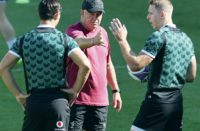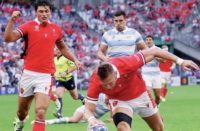
It’s not just about looking after players during a game, but their long-term health for the years after rugby.
The game gave me everything but there have been times when I’ve asked myself if the headaches and loss of concentration I sometimes experience now are down to the countless knocks to the head I received during my career.
My career was spent in a time when no-one really had a full understanding about head injuries. The mind-set was completely different. We knew rugby was a contact sport so if you couldn’t see the injury then you just got on with it.
Goodness knows how many bangs I took to the head, but the truth is that I probably suffered a concussion-type injury once every three games I played. That’s no exaggeration and over a 15-year career, that a lot of knocks to the head.
I don’t know whether the problems I suffer now are a direct result of those head injuries but it’s little wonder we now hear of other former players suffering dizzy spells, head-aches and memory loss.
For obvious reasons, I was someone who did their best to avoid as much physical contact as possible!
But countless times I was caught with a heavy blow that left me literally seeing stars, my mind went blank and I just didn’t know quite where I was for a moment.
Back then, people thought concussion meant being knocked-out, but we have since realised that it doesn’t.
I remember – albeit rather a patchy memory – the game against South Africa in Cardiff, 2010. It was George North‘s Test debut. Late in the first half, I was dump-tackled by Francois Steyn. The impact dislocated my shoulder but also banged my head on the turf.
I don’t remember the next three minutes of the game and having seen it back, I was standing looking the wrong way when I got back to my feet.
I just told myself: “Shane you’ve got to pull yourself together and last until half-time,”, but because my head was like a fog, my brain didn’t even know that my shoulder was dislocated, even though it was completely out of place.
So I carried on playing regardless, even with the likes of Bakkies Botha and Bismarck du Plessis on the pitch who can cause real damage. To be out there on the pitch only half conscious against those Springboks, who can make a mess of you, was dangerous.
I am not saying this was anyone’s fault, certainly not the Wales team who now take great care of their players, as we’ve seen with George North. Most of the time back then, players tried to hide their injuries from the physios and hoped no-one saw it.
I remember other club games when I’ve spoken to players after they’ve taken a big blow and they look at you as if you’re not there.
So the ‘Cudmore issue’ of players being sent back onto the pitch after failing a head injury assessment is a completely different matter and raises real concerns.
Jamie is one of the hardest players to have played the game in recent years. At 6ft 6in and 19st, he was built to take a few big bangs. He was the enforcer in the team who was expected to dish out pain to opponents. But the concern is that he will pay for it in the long term.
So the fact that a man-mountain like Jamie has suffered these injuries is proof that concussion is bigger than any player.
Players also need to take some responsibility. They have to get to a point where they understand that head injuries can not only affect your performance, and that of the team, but have a big impact on later life for you and your family.
We ask these guys to put their bodies on the line, but there has to be a limit.
























